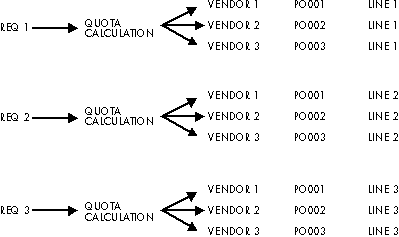Documentation >
MAC-PAC Reference Library >
Distribution >
Purchasing >
Key Concepts and Procedures >
Vendor Allocation >
Requisition Assignment
Requisition Assignment
Once requisition lines have been selected for allocation, the appropriate quota is calculated, and the vendor allocation percentages are determined. The allocation program then generates PO releases which are allocated to open and not filled Purchase Orders. Allocation processing identifies the way in which PO requisition lines will be allocated to Purchase Orders. This can be done in two ways: by Item or by Requisition.
Scheduled releases can be generated only if an open Blanket PO exists for that item which has not been completely filled. They will also take into account:
1. The minimum order quantity entered on the Item/Vendor Relationship,
2. The requisition quantity not yet allocated to the different vendors,
3. The maximum line quantity entered when the Purchase Order was created,
When allocating requisition lines by item or by requisition, the program applies the quota percentage (no matter which method was used for calculation) to the requisition line amount. Purchase Order Releases are generated as soon as the quotas have been calculated, with one PO release per requisition line. The difference between the two methods is the way the PO requisition lines are applied to Purchase Orders.
Allocation Methods
If allocated by item, the first release will determine the target PO. This is done by matching the release dates with the dates of open POs. Each requisition is applied until they have all been processed or until the PO maximum amount is reached. If the maximum amount of the PO is reached, the remaining releases will be left as open requisition lines and will be shown on the Non Allocated Purchase Requisition Report (PO280B). The following illustration shows a requisition being allocated by item.

Allocation by Item
If allocated by requisition, PO releases are applied to the first available open PO. Each requisition is applied until all requisitions have been processed. If the maximum amount of the PO is reached, the program will search for other available POs to which it would apply the remaining releases. The following illustration shows a requisition being allocated by requisition.

Allocation by Requisition
Whether releases are allocated by item or by requisition, if the requisitioned quantity is less than the minimum order quantity established for the Item/Vendor relationship, the minimum quantity will be ordered. This amount will be recorded as an over-allocation and will automatically be taken into account in future quota percentage calculations. If the quota has been calculated by Planned Quantity, the over-allocated amount will be taken into account the next time the Vendor Allocation program is run. In the case that the quota has been calculated by Planned Quantity Not Accounted For, the over-allocated quantity will be taken into account when the next requisition line is processed.
After Purchase Orders have been printed, if an outstanding PO requisition exists for a vendor, a Forecast field will be displayed on the Purchase Order Print report (PO630A). This field represents the total number of items on outstanding requisition lines that will be included on future Purchase Orders.
Note: The presence of a minimum order quantity at the Item/Vendor relationship level can require over-allocation (when the Purchase Order release is issued for a larger quantity than the Requisitioned Quantity). In this case, the over-allocated amount will be taken into account when the following release is created.